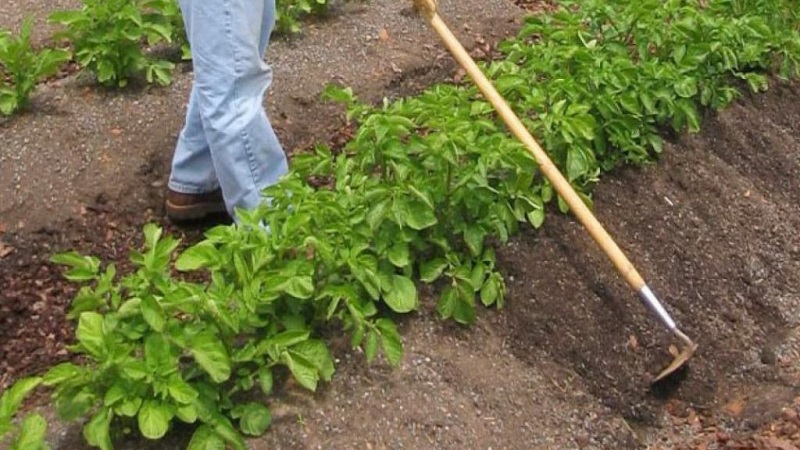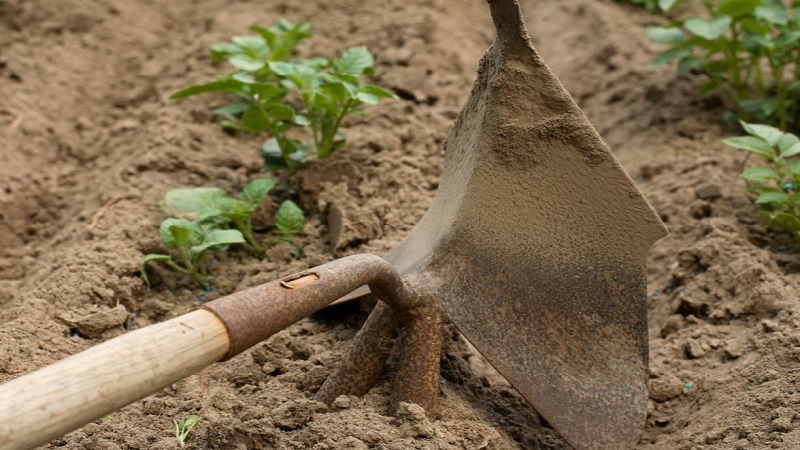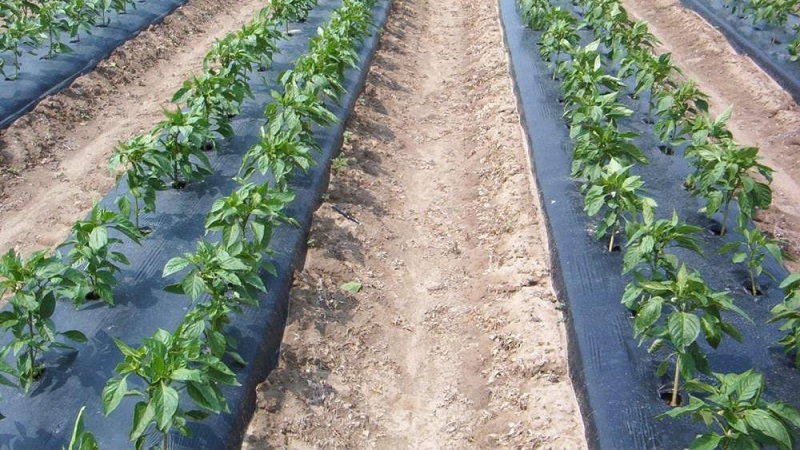Why do you need hilling potatoes and how to carry it out correctly
Potatoes are an unpretentious culture. But with a little effort, you can significantly increase yields. Hilling potato beds is one of the measures used to grow even, healthy tubers.
We will tell you in detail about how to properly hilling potatoes, why it is done and why this procedure helps to increase the yield.
The content of the article
What is hilling
Along with with weeding and by loosening the soil when caring for planting potatoes, hilling is used. The essence of the procedure is to powder the base of the bush with loose, moist earth.
The meaning and timing of the procedure
Why do they spud plantings? This simple technique allows you to save young bushes from the spring cold, prevents bulging of tubers to the surface and increases productivity.... In addition, formed tall bushes are better illuminated without shading each other.

Hilling is carried out in several stages... The first time the bushes are sprinkled with soil as soon as they appear above the ground. If the weather is unstable and there is a likelihood of return frosts, the plants are completely covered with earth. This protects young shoots from the cold and does not harm the bush. If the weather is warm, it makes no sense to fall asleep completely, this will only slow down the growth of the bushes.
The second hilling is carried out 2-3 weeks after the first... Third - when the bushes reach a height of 15-20 cm. At the same time, the base of the shoots is sprinkled, forming ridges 15-20 cm high. During this period, a lot of earth is sprinkled on the bushes. This prevents the bush from falling apart in different directions and the appearance of tubers on the soil surface.
The fourth hilling is rarely used... It is advisable if the bushes grow in breadth and the tubers begin to look out of the ground.
Impact on yield
How does hilling affect yields? Adding soil to the base of the bush provokes the growth of new tubers on top of the already formed.
Need to know! Tubers form on thin stems (stolons) that emerge from the main stems. The longer the underground part of the potato bush, the more stolons are formed.
In addition, the crop likes to grow in cool soil. Hilling protects the plant from overheating and maintains optimal conditions.
When it reaches a height of 15-20 cm above the ground, the plant stops growing and directs all its forces to the growth of the formed tubers.
Dusting with damp earth makes the shoots grow taller and produce new stolons in addition to those already available.

How often to repeat the procedure
If the soil on the site is loose and fertile, it is enough to huddle the potatoes twice during the growth... If the soil is heavy or the bushes begin to fall apart, hilling is carried out 3-4 times per season.
Time spending
Hilling, like loosening and removing weeds, is carried out after rain or watering... In the heat, they are treated in the early morning or evening. This will make it easier for the bushes to recover from damage.
Important! After the beginning of flowering, weeding and hilling plantings is not recommended. During this period, stolons (future tubers) are actively formed, and it is easy to damage them when cultivating the land.
Is it possible to do without hilling
With all the undoubted advantages, hilling potatoes is a process that requires a significant investment of time and effort.And if the plantings cover a large area, one treatment can take several days.
Is it possible to do without this procedure? Yes, it is possible. Potatoes that do not need hilling are grown in two ways, allowing you to minimize care.
Film landing
The dug and leveled soil is covered with a covering non-woven material of black color... Holes are made in the tissue according to the seeding pattern and the seed is laid out.

Further care for such plantings is watering and preventive treatments for pests and diseases.
Read also:
Planting under straw
Another sowing method, allowing you to do without the tedious hilling and weeding. The method is based on the well-known mulching technique.
Sowing technology looks like this. Seed potatoes are laid out on top of the dug and leveled soil and sprinkled with a layer of earth. After that, the entire area is covered with dry straw. There should be a lot of straw, at least 30-50 cm.
The advantages of the method are that under the straw "blanket" the soil retains moisture and remains loose, and the weed does not grow. Disadvantage: in a damp summer, under straw can develop late blight.
Instruments
For processing plantings, hand tools and mechanized devices are used, which greatly facilitate the work of the summer resident. Let's tell you more about them.
Chopper, or hoe
A popular and affordable method for manually cultivating potato beds... With the help of the tool, the soil is raked to the bush from all sides or the stems are gently moved apart and the earth is poured into the middle of the bush. The ridges are formed wide and high, then the root system has enough soil volume for growth and protection from overheating.
Shovel
In the absence of other tools, you can also spud potatoes with a shovel. Of all the hand tools, this is the least convenient option.
Manual hiller
The designs of the manual hiller are different. There are simple home-made options and factory, more complex ones. The tool is convenient because it cultivates the soil only in the aisles, simplifying and speeding up the process.
Hand plow
A manual disc plow is used for planting maintenance (hilling, loosening, weeding) and for processing the land after harvest... You can make the tool yourself or purchase a ready-made one.
Motoblock
It is advisable to process large potato plantings with mechanized devices... For hilling, for example, a walk-behind tractor with various attachments is used.
When growing potatoes, the walk-behind tractor is used all season from the moment of plowing the soil to harvesting. The disadvantage is the high cost of the device and the fuel for it. In addition, with inept processing, there is a risk of severely damaging the bushes.

Cultivator
Another mechanical assistant. Motor-cultivators are manual, electric and gasoline-powered. They help not only when hilling, but also when weeding and loosening the soil.
Useful Tips
Tips from experienced gardeners will help to spud potatoes correctly:
- With the beginning of the flowering period, hilling is stopped. During this period, the risk of damage to the stolons is high.
- The second and subsequent treatments are best done manually. This minimizes the likelihood of injury to plants.
- If the soil is loose and fertile, and the bush begins to fall apart during its growth, it is permissible to carry out more than three hilling in order to avoid bulging tubers to the surface of the earth.
- The depth and darkness improve the taste of the tubers, therefore, during the second and subsequent hilling, scoop up more soil to the bush (the height of the ridge should be at least 18-20 cm).
Conclusion
Hilling potato bushes is to cover the base of the stems with loose earth. The procedure increases the yield and protects the tubers from the sun's rays. Hilling is carried out in 2-3 stages before the onset of the flowering period.